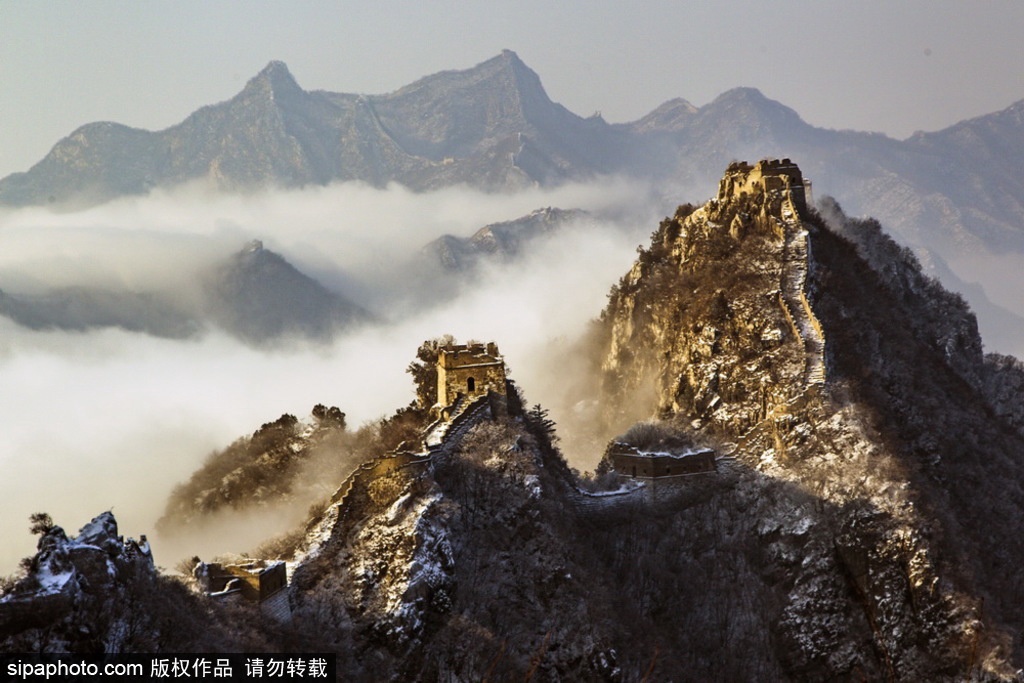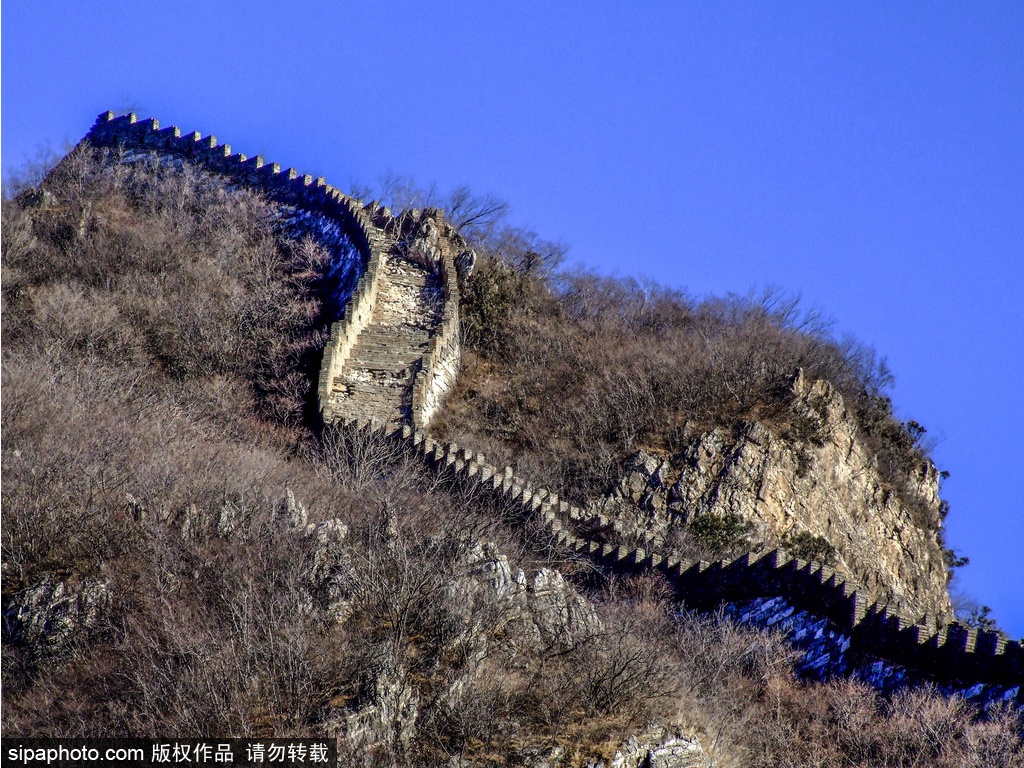
Key Words:World Cultural Heritage,Landscape,
The mountains are of various shapes, so that this section looks great and full of challenge Jiankou Great Wall is famous for its W-shape and the dilapidated original form.
Admission:Free but it is difficult to reach there.
Opening Hours:All day
Phone:No
Best time to visit:June-Oct.
Recommended Time for a Visit:2 days

Description
Jiankou Great Wall is located in Huairou District, 10 km from Mutianyu Great Wall in the east, about 80 km from downtown Beijing. The mountains are of various shapes, so that this section looks great and full of challenge. Jiankou Great Wall is famous for its W-shape and the dilapidated original form.
Owing to the need for renovation, it is regarded as one of the most dangerous sections of the Ming's wall. It connects to Mutianyu in the east and joins Huanghuacheng in the west. From east to north, the wall zigzags 9.3 miles from "The Ox Horn Edge Wall" to "The Nine-Eye Tower" via "The Beijing Knot". Compared with Mutianyu, the mountain is higher and steeper, while compared with Simatai, it is more winding and varied.
There are many famous sections of Arrow Nock, such as "The Nine-Eye Tower", an important command post during the ancient wars. It has three layers, and there are nine holes which look like nine eyes on each side. "The Beijing Knot" is the meeting point for three walls coming from different directions. "The Sky Stair", is a precipitous stair whose angle of elevation is 70 to 80 degrees. It leads to "The Eagle Flies Facing Upward", a watch tower built on the lofty peaks.
The area has been chosen by artists as the best section of the Great Wall for painting and by photographers as one of the best section for photography. It is said that most of the paintings of the Great Wall sold in China are those of Jiankou Great Wall.
Scenic spots
Nine-Eye Tower

It is at the northernmost point of this section. This tower with three storeys was an important command post during the ancient wars. There are nine holes on each side of the wall which look like nine eyes, hence its name. If the weather is fine, you can overlook the city of Beijing from the tower, so it is also named Wangjing (Overlooking Beijing) Tower.
Beijing Knot
It is the meeting point of three sections of the Great Wall coming from different directions. The west route leads to Huanghuacheng, a section built by a clear lake. You will pass another section Xiangshuihu in the midway, which is not so famous but also very beautiful. Walking north, you will get to the Nine-Eye Tower, the north end of Jiankou section. You can hike to Mutianyu following the south path.
Beijing Knot is a great sightseeing point, with lush mountains around it. Getting there at sunrise or sunset, you may encounter the breath-taking sight of a wide sea of cloud.
Eagle Flies Facing Upward
It is one of the most dangerous segments of the Great Wall. The place got its name because the watchtower and the lofty peaks there form a shape of an eagle. The posture of this 'eagle' is a vivid example to tell visitors that stairs there are so steep that even eagles have to fly facing upward to reach the top.
Sky Stair
Sky Stair is a precipitous stair, whose angle of elevation is 70 to 80 degrees, at the east slope of the Eagle Flies Facing Upward. Some parts of it are so narrow that only one person can get through at a time.
Jiankou Spot
It is the lowest point of this section, looking like the mouth of the mountain creek among the rolling mountains.
Zhengbei Tower
It is the highest point of this section, built on the top of steep cliffs. It is also the largest and the most complete watchtower along this section. The gentler path on the east leads to the Ox Horn Edge Wall, the east end of this section.
How to Tour Jiankou Great Wall
1. This section can be roughly divided into three parts: north part (Nine-Eye Tower to Beijing Knot), middle part (Beijing Knot to Jiankou Spot), and south part (Jiankou Spot to Ox Horn Edge Wall). Generally, you need to spend about one day climbing only one part. If you plan a two-day trip, you can finish two parts, even the whole section.
2. The middle part is the essence of this section, including Beijing Knot, Eagle Flies Facing Upward, and Sky Stair. However, the almost vertical stairs of Sky Stair make it the most difficult part to conquer.
3. The other popular part is the south part. You can take great photos from there. The segment from Jiankou Spot to Zhengbei Tower is not easy to climb, while the rest of it is quite flat. Walking eastwards along the path, you can get to Mutianyu section.
4. The north part is suitable for visitors who are not good at sports. Besides the remnants, there are peach trees on the two sides of the wall. In spring (April and May), the blooming blossoms will refresh you with its sweet smell.
5. There are Xizhazi Village and Wofo Mountain Villa at the foot of this section, which are regarded as the starting point of the Jiankou hiking. There are footpaths from the two places, leading to the major spots of this section. You need to spend 1–2 hours climbing up the mountain through a forest to get to the Great Wall.
6. Those who are very energetic can challenge themselves by hiking the whole route in two days. If there is still time and energy left, you can hike to Mutianyu following the path to the east. It would take about 1.5 hours to get there from the Zhengdong Tower.

Hiking Tips
The terrain at Beijing Knot is relatively flat. If you plan a two-day trip and decide to spend the night on the wall, Beijing Knot is the best site to set the tent.
The Xizhazi Village on the north of the Great Wall and Wofo Mountain Villa on the south provide accommodation, so do other villages at the mountain foot. You can also stay overnight there.
Climbing this section needs a lot of energy. But there is no booth up there. You need to take some snacks and bottled water. Before or after hiking, you can go to Xizhazi Village or the Wofo Mountain Villa to treat yourself with some local dishes.
You'd better take mountaineering equipments, like hiking boots, alpenstock, gloves, and climbing rope. Sometimes you need to make a detour in segments which are badly damaged.
Seniors and children are not recommended to climb this section.
As a famous section of Wild Great Wall, it is free to hike. But sometimes, local villagers will set roadblocks and charge you for at least CNY 10 as a toll.
Occasionally, there are villagers providing ladders to help you climb the wall. You need to pay at least CNY 5 for using the ladder.

How to Get to Jiankou from Downtown Beijing
By Bus: 916 Express
Take bus line 916 Express from Dongzhimen Hub, near Dongzhimen Subway Station and get off at Huairou North Avenue (Huairou Beidajie). From there, change to bus line h36 to Tianxianyu and then walk to the entrance of Jiankou Great Wall.



